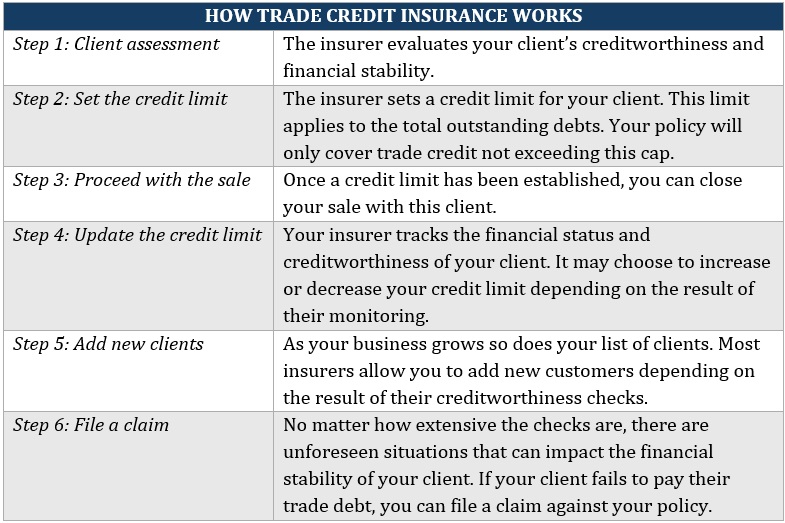

Updated August 13, 2024
If your business offers goods or services on credit terms, then there’s always the risk that a buyer is unable to pay. Depending on how big a delinquent client’s orders are, one bad debt can have a huge financial impact on your operations.
This highlights the need for trade credit insurance. This form of risk management tool protects your business against losses from non-payment of a trade debt.
In this client education article, Insurance Business explains how this type of coverage works. We will also give you a rundown of how this policy can benefit Australian businesses and what you should look for to get the right coverage. Insurance agents and brokers can also share this guide with their clients who may be searching for ways to protect their business assets.
Trade credit insurance protects your business’ accounts receivables against losses resulting from unpaid commercial debt. This form of business insurance reimburses a portion of the outstanding debt if a client is unable to pay due to various reasons. Coverage may also include transactions where payment is overly delayed.
Depending on your insurance provider, this policy can also be called export credit insurance, accounts receivable insurance, or debtor insurance.
In Australia, a trade credit policy covers two types of risks:
Trade credit insurance protects your business if your customers fail to settle outstanding debts due to financial problems. These include bankruptcy, insolvency, and protracted default.
Your policy covers risks that are beyond your clients’ control such as war and terrorism. Some policies also provide coverage for unpaid debts resulting from the impacts of natural calamities, including wildfires, storms, and earthquakes. Coverage may also be triggered if a country’s change of rules or economic situation restricts the transfer of money.
Depending on your business’ needs, you can structure your trade credit insurance policy in three ways:
This policy protects your business against losses from unpaid trade debt from all customers. You can further structure the policy to cover both domestic and foreign clients.
This type of policy may cover one or all transactions with a specific client. That’s why it is sometimes referred to as transactional trade credit insurance.
This policy covers your business’ biggest clients whose unpaid trade debts pose the greatest risk to your operations.
Some insurance companies also offer an excess-of-loss policy. Coverage includes catastrophic or exceptional losses from your largest customers. The policy covers your business if the outstanding balance exceeds the normal levels of bad debt.
Like most business insurance policies, trade credit coverage comes with a deductible. This is the amount you need to pay out of pocket before coverage kicks in. As a rule, the higher the deductible, the lower the insurance premiums and vice versa. With a higher deductible, your insurance provider assumes lower risks.
Learn more about how insurance deductibles work in this client education guide.
At the beginning of the policy, your trade credit insurance provider assesses the financial stability and creditworthiness of your insurable clients. After this, your insurer will assign an appropriate coverage limit. This is the maximum amount the insurance company will reimburse you if a client is unable to pay.
Some insurers will continue to monitor your client’s financial standing to ensure they maintain their creditworthiness. These providers will also notify you if a customer is experiencing financial issues. They may also work with your business to come up with a plan to mitigate potential losses.
Generally, you can purchase additional coverage for a specific client or extend your policy to include a new buyer if needed.
Here’s an overview of how trade credit insurance works:

Trade credit insurance is just one of the several types of commercial policies that can help you keep your business profitable. Find out which other policies suit your operations in this guide to business insurance in Australia.
All businesses that offer products and services on credit terms can benefit from taking out trade credit insurance. These include manufacturers, traders, and service providers.
If you’re a seller, this form of business insurance can protect you financially if one of your buyers is unable to pay. It insures you against customers who declare insolvency, bankruptcy, or a similar legal status. Your policy also covers you if a client has been allowed to postpone payments because of a bankruptcy protection arrangement.
According to the International Credit Insurance & Surety Association (ICISA), trade credit insurance pays most of the unpaid debt.
“If a buyer does not pay, the trade credit insurance policy will pay out a percentage of the outstanding debt,” a spokesperson from the trade body told Insurance Business. “This percentage usually ranges from 75% to 95% of the invoice amount but may be higher or lower depending on the type of cover that was purchased.
“Trade credit insurance policies are flexible and allow the policyholder to cover the entire portfolio or just the key accounts against corporate insolvency, bankruptcy, and bad debts.”
Trade credit insurance generally costs around a tenth to a quarter of a cent for every dollar of your overall yearly sales. This means that if your business makes around $1 million in sales, your premiums can range between $1,000 and $2,500, excluding fees and taxes.
Your annual premiums, however, can be higher or lower depending on other factors, including:
You can purchase trade credit insurance for domestic and international clients. Most policies also come with customisable features and benefits to suit your business’ unique needs.
To ensure that you are getting the right coverage, there are several key factors that you need to consider when shopping for trade credit insurance:
Your policy should cover the different risks your customers face. Most policies provide coverage not only for commercial risks, but also for situations beyond your client’s control such as political upheavals, economic downturns, and natural disasters. To have a clear understanding of what a policy covers, ask the insurer for a detailed explanation of how they can accommodate different types of risks.
Trade credit insurance companies have different requirements regarding who can qualify for coverage. Ask the insurer to give a clear outline of what affects eligibility. Some providers impose limits on the number of unsettled debts they can cover. Go with a policy with flexible terms that can accommodate your business as it grows.
Your premiums are dictated by a set of factors that may be different than those of other businesses. To find out what goes into your annual premiums, go through the policy document for the full breakdown. This can help you avoid paying for unnecessary coverage. You can also consult an experienced insurance agent or broker to provide a clear picture of where your payments go.
Trade payment issues can come up without warning, that’s why it is best to choose an insurer with robust customer support services. See if they offer 24/7 support to address urgent cases.
Filing an insurance claim can be a complicated process that often requires the help of an experienced agent or broker. Go with a trade credit insurance provider with a reputation for handling claims fairly and promptly and has the financial capability to pay out claims.
While trade credit insurance is not mandatory, there are several benefits for getting coverage, especially for businesses offering products and services on credit terms:
The key to unlocking these benefits is getting the proper coverage at the right time.
Some businesses, however, only turn to trade credit insurance when they already have a credit issue or foresee exposure. Unfortunately, this is often too late for insurance companies to take on the risk.
“Trade credit insurance can help companies apply longer term risk management strategies,” said Yue Ma, vice-president and senior underwriter for political risk and sovereign credit at Sovereign Risk Insurance Ltd. “We would advise firms to consider trade credit insurance when business is good, so that when a problem does strike, they don’t find themselves trying to get coverage for an uninsurable risk.”
Trade credit insurance is just one of the several ways that your business can protect against commercial debt. Here are some alternatives for this type of coverage.
Self-insurance is the main alternative to a trade credit policy. Businesses that choose to go this route can put a reserve on their balance sheet to cover any bad debt that may be incurred over a financial year.
Self-insurance, however, is not the most capital efficient solution according to James Daly, CEO of Americas region at Allianz Trade. “Rather than have capital in your balance sheet doing nothing but waiting for bad debt, why not purchase trade credit insurance and then invest that excess capital into growth or new products?”
On its website, Allianz Trade reminds businesses that they cannot rely solely on trade credit insurance to reduce the risk of potential losses resulting from bad trade debt.
“Credit insurance is not a substitute for prudent, thoughtful credit management,” the insurer said. “Sound credit management practices should be the foundation of any credit insurance policy and partnership. Credit insurance goes beyond indemnification and does not replace a company’s credit practices, but rather supplements and enhances the job of a credit professional.”
Our Best in Insurance Special Reports page is the place to go if you are looking for trade credit insurance providers in Australia that provide top-notch coverage. The insurers in our special reports have been nominated by their peers and vetted by our panel of experts as respected and reliable market leaders.
By partnering with these companies, you can be sure that your accounts receivables are protected if unexpected issues occur.
Have you experienced filing a claim against your trade credit insurance policy? Let us know how it went in the comments.
